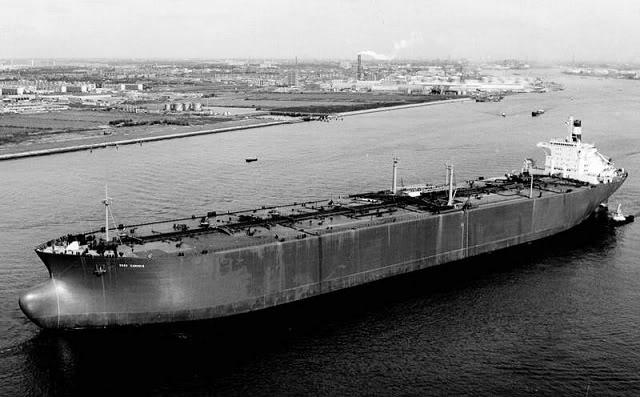Auke Visser´s Esso UK Tanker's site | home
MASTER OF THIS GIANT (What It's Like To Be)
From : The Peoples Journal, Saturday, November 15, 1969.
HOW would you feel if you were in command of this monster, 1141 feet long and as near as dammit a quarter of a million tons?
 This photo of the Esso Scotia shows the width as well as the length of the monster.
That's what we asked its captain, 41-year-old lan D. Smith, 44 Durham Street, Monifieth, Angus.
"It's just another ship," he says. " If I stopped to think or the responsibility on my shoulders I'd go up the wall."
This ship is the Esso Scotia, 249,500 tons deadweight, the largest ship to dock in Britain. And the only berth that can take her is at Milford Haven. The drydock for her is at, Lisbon and she just gets in.
Captain Smith is quietly proud of his leviathan, the longest ship in the World. Yet, her crew numbers just 31 - each with a cabin to himself.
Below - Captain Smith at a reception on board.
 "They have their own bar and cinema which they run themselves, and there is also a swimming pool. The officers also have a bar and a cinema."
Captain Smith watched the Esso Scotia grow, at Bremen, in Germany, where she was launched on March 31.
She has just completed her successful maiden voyage, and Captain Smith told us about her at his home.
With that 1141 length she has a beam of 170 feet. Her draught is 65 feet 6 inches.
Her engines develop a shaft horsepower of 32,000, which drives her along at 16 1/4 knots fully laden.
She has only one main boiler, with an auxiliary which can get her to port at a modest six knots.
When she did her sea trials in the Bay of Biscay it took 174 minutes to bring her to a stop from full speed, using the propellors in reverse.
It took five minutes to stop her by slewing her right round.
The stopping technique is a compromise. "We slew her 30 degrees at a time.
"Size is the problem," says Captain Smith. "At sea she's just another ship. Somehow she doesn't seem so big after a while - that is, until you ..reach port."
They use bikes
There are a couple ot bicycles to get around the vast acreage of deck.
"The boilers are automatic, and worked very well on the maiden voyage," said Captain Smith. "We control the engines by telegraph from the bridge. There is an engine control room where an eye is kept on the systems, but everything is really done from the bridge.
"At Milford Haven, a radar system has been installed which gives the speed of approach towards the jetty. we berthed at two feet per minute."
At that one is hardly aware of movement. But, even so, a slight miscalculation could lead to a costly nudge that would probably leave a large dent in the Welsh coastline.
Largest cargo
The maiden voyage lasted two months, to. Mena al Ahmadi ini the Persian Gulf and back, with the largest cargo
ever discharged in this country - 243,560 tons of crude oil, the equivalent of 76j million gallons.
There was a brief stop off Capetown on the outward trip for spares to be brought aboard by lighter. Another was made on the return trip to collect fresh food, mail and films. These come by helicopter which lands on the pad on the upper deck.
"This is a regular service," said Captain Smith. "We get our cinema films and mail brought out by helicopter, and any supplies up to 1000 Ib. We need not stop for the helicopter, but reduce to manoeuvring speed."
When the ship returned to Britain she had to discharge 27,000 tons of oil into the Esso York at Lyme Bay. This was to reduce her draught by five feet and allow her into the allotted berth at Milford Haven. She created another record with the rate of discharge, over 8000 tons an hour, the highest in any port.
A good crew
"My crew of 31 is an integrated crew,'' officers, chief petty officers, petty officers and operatives," said Captain Smith.
"Deck operatives can work in the engineroom and vice versa. The men do a variety of jobs. Even the stewards are able to help with the mooring ropes. I've got a good crew."
The Esso Scotia's vast bulk is brought home forcibly if, she stops at sea. Deadweight takes on a more than nautical cbnnotation when she restarts.
"It takes a long time to get her moving again," said Captain Smith of his near - £8 - million charge. " She costs £12,000 a day to run, and burns 160 -Tons of fuel a day."
Captain" Smith has leen in tankers for 25 years.
He took his master's ticket in 1955, and became relieving master of the 90,000 ton Esso Yorkshire. His first permanent command was the Esso York of 28,000 tons, and he commanded the Esso Milford Haven for 12 months before he stood by his present ship.
He is married and has two daughters and a son.
There was a nice totich when he was asked what his tartan was.
"I told the company that, with a name like Smith, I couldn't claim a tartan, so they asked me what my wife's tartan was.
"So as a result we have Mackenzie tartan curtains in the officers' bar."
|